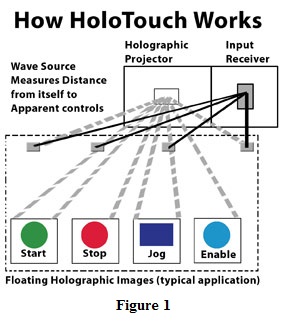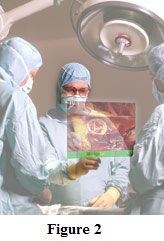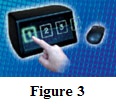In April 2002, HoloTouch®, Inc., a Delaware corporation with offices in Darien, Connecticut, announced that its founder and President, R. Douglas McPheters, had been granted a U.S. Patent for his “holographic control arrangements.” This innovative technology allows operators to actuate and control a wide variety of electronic devices by simply passing fingers through colorful, three-dimensional holographic images floating in the air at a location convenient to the user.

Utilizing well-developed wave source technologies, an infra-red detector or laser scans the plane of the holographic images, detects the intrusion of a finger into the defined area of the images, identifies which number or symbol has been selected and transmits the selection to the equipment’s internal software, much the same way pressing a button on any ordinary keypad would (see Figure 1). Interestingly, this basic technology was envisioned by McPheters while writing a thriller (as yet unpublished) about a Manhattan lawyer who starts a loan sharking operation in what’s left of the Soviet Union.
Solving Problems for the Future
HoloTouch solves many problems inherent in conventional tactile keypads and keyboards, particularly those regularly subject to contaminants, dirt, moisture, temperature fluctuations and shock. The easy-to-use interfaces can provide reliable operation of equipment where conventional tactile interface sizes have shrunk below normal finger size.
 There is no wear with repeated operation because HoloTouch interfaces have no moving parts to fail under normal or even heavy use. Because there’s nothing to physically touch when using HoloTouch, healthcare personnel can gain direct, reliable control of operating room equipment where actuation and control must be indirect because computer keyboards cannot be effectively sterilized (see Figure 2). Further, contrary to many new technologies, HoloTouch interfaces are cost-effective, both initially and over time.
There is no wear with repeated operation because HoloTouch interfaces have no moving parts to fail under normal or even heavy use. Because there’s nothing to physically touch when using HoloTouch, healthcare personnel can gain direct, reliable control of operating room equipment where actuation and control must be indirect because computer keyboards cannot be effectively sterilized (see Figure 2). Further, contrary to many new technologies, HoloTouch interfaces are cost-effective, both initially and over time.
One of the first products using HoloTouch technology has been created by Atlantex Corporation. The two companies recently announced that their fully functional touchless holographic interface, BeamOne (www.holodemo.com), won a 2004 Control Engineering Editors’ Choice Award as “among the most significant innovations featured in Control Engineering during the past year.”

BeamOne (see Figure 3), is seen by PCs as a keypad and allows operators to control equipment by simply passing a finger through holographic images of “keys” floating in the air. The 1-inch square holographic “keys” are projected several inches in front of the hardware. Power and communications are provided by the PC’s USB port and sensors in BeamOne detect an operator’s interaction with the holographic images operating as a simple 4-button keypad. The BeamOne product has already been purchased by several large automakers to evaluate for use in their products and production facilities.
Originally Published: March 1, 2005

